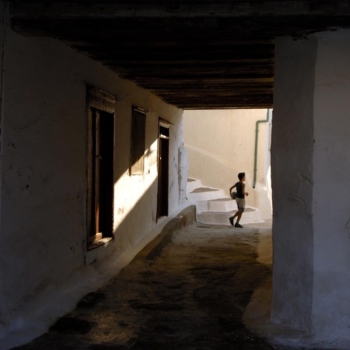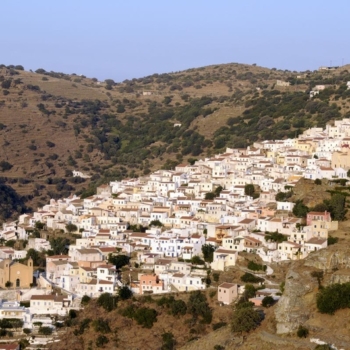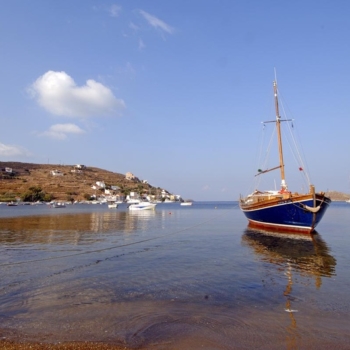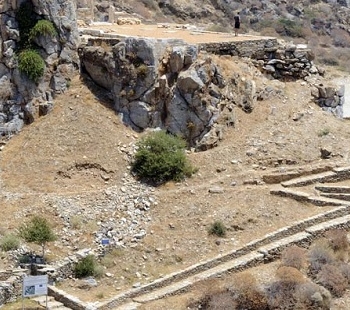The only one out of the four ancient towns of Kea built at the inland is Ioulis, or Chora. It was founded in the archaic period and today the ruins of the ancient acropolis’s forts and section of the wall are preserved. Due to its position it remained an important and active centre and this is why the Venetian rulers had built a castle there in the 13th century, part of which is still preserved. The morphology of Chora, which is built amphitheatrically on the slope, has affected its town planning and enabled the maintainance of its traditional character.
It consists of four settlements, which were related to the social status of the residents in the past. The wealthier residents, landowners and merchants, lived at the lowest point, the castle, where one can see bigger urban houses and mansions.
The flattest section of Ioulis, Messada, was the meeting point for the social classes, mainly for transactional purposes, since the distances between the social classes were kept based on behavioural rules. The eldest people claim that the life of the wealthy Tzia people was quite different, influenced by the urban lifestyle, and that the sounds of their pianos often mixed with those of the traditional ‘tsambounes’ (bagpipes) were heard by the upper neighborhoods.
THE MUSEUM, THE HISTORICAL TOWN HALL AND THE NEW TOWN HALL
Passing the arcade (‘stegadi’) at the entrance of Ioulis, you will see a small square. A road on the left leads to the castle area. The relatively wide pebbled road leads to the central square passing in front of the Archaeological Museum, which is one of the most important in the Cyclades, due to its important prehistoric exhibits.
A bit further above the museum the central square is located with the neoclassic building which houses the Historical Town Hall and it was built by the architect E. Ziller, in 1902. It stands out not only for its architecture, but also for its interior decoration. In the façade there are clay statues of Apollo and Hermes. On the western side an ancient sculpture with a female form has been immured. On the ground floor of the building there is the Citizens Service Centre of the Municipality of Kea. Further south, on the edge of the settlement, the New Town Hall is located.
The New Town Hall was studied by the architect Kallias in 1898 based on the modern architectural suggestions of Ernst Ziller. It was built in 1909 and it was used as a school building until 2002. It was renovated in 2010 and it housed the New Town Hall and the services of the Regional Unit of Kea-Kythnos.
In a building further down the New Town Hall, the Cultural Centre of Ioulis is housed which has the Municipal Lending Library and the Historical Archive as well as the Film Club of Kea.
Water Fountains and Churches
Above the central square, the alleys with the ‘stegadia’, the stairs and the winding routes between the houses begin. On your tours you will meet many water fountains with running water, as Chora had a very robust system of water supply from springs. It is said that the best water spurts in the water fountain of Kourentis. On the southern borders of the settlement there are the demolished windmills and the New Town Hall.
The churches of Ioulis are interesting as well: Agios Spyridonas, Evangelismos and Panagia Rematiani. The church of the patron saint Agios Charalambos is located in Chora as well. However, the main church is the so-called Demotikia at the district Katohori, dedicated to the Annunciation of Virgin Mary.
If you follow the alternative route from Ioulis to Kastriani you will see the ruins of the monastery of Agia Anna, where you will arrive by turning left on the dirt road just a bit after the junction towards Pera Meria. Returning to the main road you will find the spring of Pyrgos and further down the renowned spring of Veniamin, below high, vertical rocks.
In addition, just outside Ioulis there is Leon, a stone dominating lion carved on the rock. The lion dates back to the archaic years and is intertwined with legends and myths of the island.
Info
In Ioulis there is the residence of artist Alekos Fassianos and his love for the island is evident in murals created in the central ‘stegadi’ and the entrance of his house.












